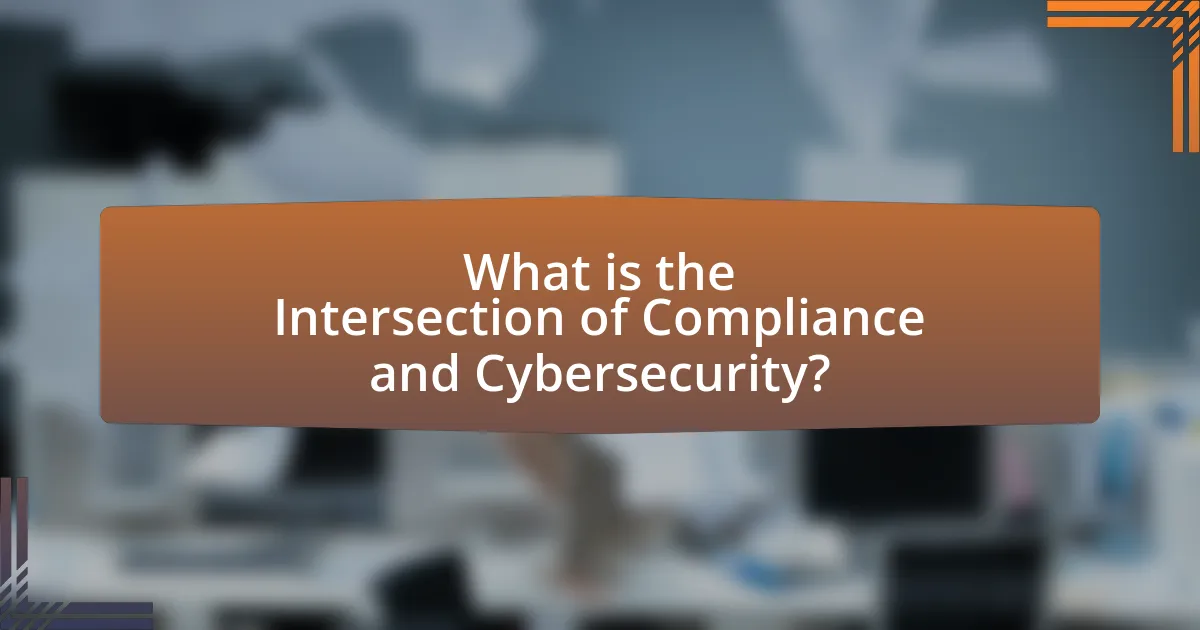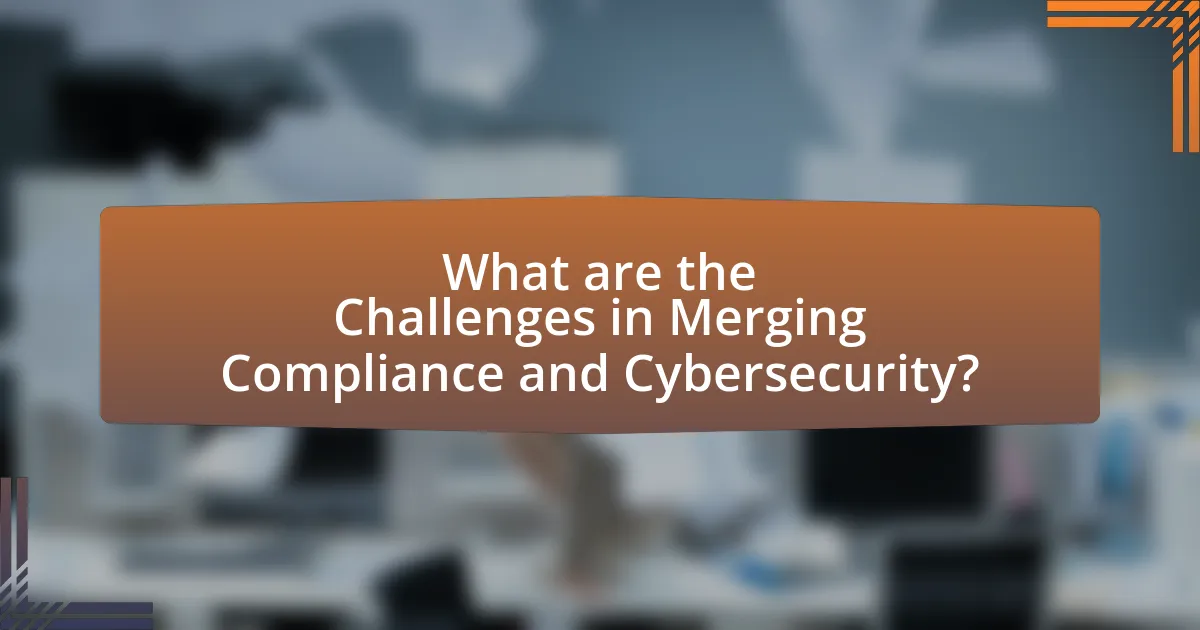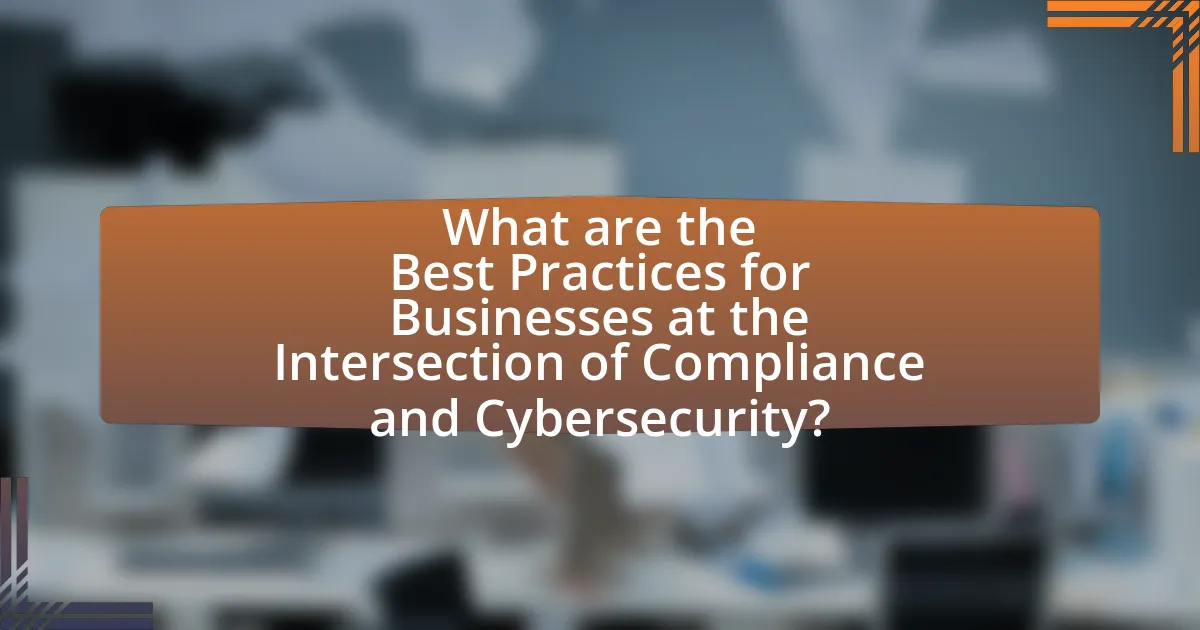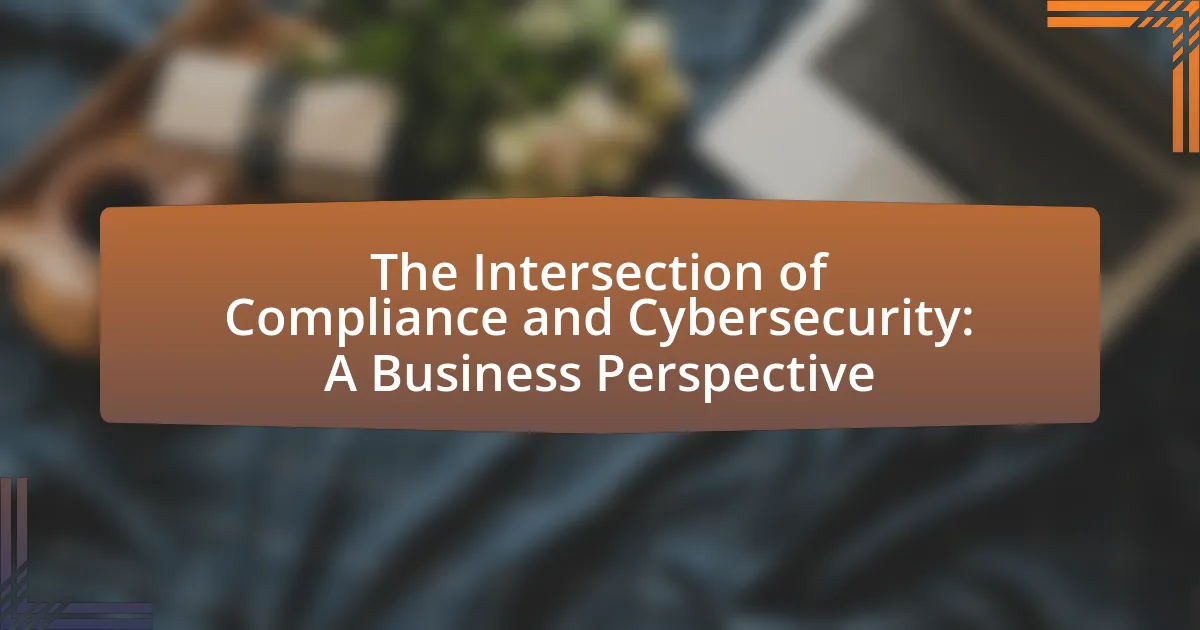The article focuses on the intersection of compliance and cybersecurity, emphasizing the necessity for organizations to align regulatory requirements with the protection of digital assets and sensitive information. It discusses key compliance regulations such as GDPR and HIPAA, which mandate specific cybersecurity measures to mitigate risks of data breaches. The article highlights the benefits of integrating compliance and cybersecurity strategies, including enhanced risk management and operational efficiency, while also addressing the challenges organizations face in merging these two critical areas. Additionally, it outlines best practices for businesses to effectively navigate compliance and cybersecurity, ensuring ongoing alignment and protection against emerging threats.

What is the Intersection of Compliance and Cybersecurity?
The intersection of compliance and cybersecurity refers to the alignment of regulatory requirements with the protection of digital assets and sensitive information. Compliance mandates, such as GDPR and HIPAA, require organizations to implement specific cybersecurity measures to safeguard data, thereby ensuring legal adherence while mitigating risks of data breaches. For instance, a study by the Ponemon Institute found that organizations with robust compliance frameworks experience 50% fewer data breaches, highlighting the critical role of compliance in enhancing cybersecurity posture.
How do compliance and cybersecurity relate to each other?
Compliance and cybersecurity are interconnected as compliance frameworks often mandate specific cybersecurity measures to protect sensitive data and ensure organizational integrity. Regulatory standards such as the General Data Protection Regulation (GDPR) and the Health Insurance Portability and Accountability Act (HIPAA) require organizations to implement robust cybersecurity practices to safeguard personal information. These regulations not only define the legal obligations but also establish best practices for risk management, data protection, and incident response, thereby reinforcing the importance of cybersecurity in achieving compliance.
What are the key compliance regulations impacting cybersecurity?
The key compliance regulations impacting cybersecurity include the General Data Protection Regulation (GDPR), the Health Insurance Portability and Accountability Act (HIPAA), the Payment Card Industry Data Security Standard (PCI DSS), and the Federal Information Security Management Act (FISMA). GDPR mandates strict data protection and privacy measures for organizations handling personal data of EU citizens, imposing fines for non-compliance. HIPAA establishes standards for protecting sensitive patient information in the healthcare sector, requiring safeguards to ensure confidentiality. PCI DSS sets security requirements for organizations that handle credit card transactions, aiming to protect cardholder data. FISMA requires federal agencies to secure their information systems, promoting a comprehensive framework for managing cybersecurity risks. These regulations collectively shape the cybersecurity landscape by enforcing standards that organizations must adhere to in order to protect sensitive information and mitigate risks.
How does cybersecurity enhance compliance efforts?
Cybersecurity enhances compliance efforts by ensuring that organizations meet regulatory requirements related to data protection and privacy. Effective cybersecurity measures, such as encryption, access controls, and regular security audits, help organizations safeguard sensitive information, thereby aligning with standards like GDPR and HIPAA. For instance, a study by the Ponemon Institute found that organizations with robust cybersecurity practices are 50% more likely to comply with regulatory requirements, demonstrating a direct correlation between cybersecurity investments and compliance success.
Why is understanding this intersection important for businesses?
Understanding the intersection of compliance and cybersecurity is crucial for businesses because it ensures they meet regulatory requirements while protecting sensitive data. Compliance frameworks, such as GDPR and HIPAA, mandate specific security measures to safeguard personal information, and failure to adhere can result in significant fines and reputational damage. For instance, a study by IBM found that the average cost of a data breach is $4.24 million, highlighting the financial implications of inadequate cybersecurity measures. Therefore, integrating compliance with cybersecurity strategies not only mitigates risks but also fosters trust with customers and stakeholders, ultimately supporting business sustainability and growth.
What risks do businesses face without compliance and cybersecurity integration?
Businesses face significant risks without compliance and cybersecurity integration, including increased vulnerability to data breaches, regulatory penalties, and reputational damage. The lack of a cohesive strategy can lead to inadequate protection of sensitive information, making organizations prime targets for cyberattacks; for instance, the 2021 IBM Cost of a Data Breach Report indicated that the average cost of a data breach was $4.24 million, underscoring the financial implications of such vulnerabilities. Additionally, non-compliance with regulations like GDPR or HIPAA can result in fines that reach millions, further exacerbating financial strain. Ultimately, the absence of integrated compliance and cybersecurity measures compromises both operational integrity and stakeholder trust.
How can businesses benefit from aligning compliance and cybersecurity strategies?
Businesses can benefit from aligning compliance and cybersecurity strategies by enhancing their risk management and operational efficiency. This alignment ensures that security measures meet regulatory requirements, reducing the likelihood of data breaches and associated penalties. For instance, a study by the Ponemon Institute found that organizations with integrated compliance and cybersecurity frameworks experienced 50% fewer data breaches compared to those with siloed approaches. Additionally, aligning these strategies streamlines processes, allowing businesses to allocate resources more effectively and respond to threats in a timely manner, ultimately leading to improved trust and reputation among customers and stakeholders.

What are the Challenges in Merging Compliance and Cybersecurity?
The challenges in merging compliance and cybersecurity include differing objectives, resource allocation, and regulatory complexity. Compliance focuses on adhering to laws and regulations, while cybersecurity emphasizes protecting data and systems from threats. This divergence can lead to conflicts in prioritization, where compliance may be seen as a checkbox exercise rather than a proactive security measure. Additionally, organizations often struggle with allocating sufficient resources to both areas, resulting in gaps in either compliance or cybersecurity efforts. Regulatory frameworks can also be complex and vary across jurisdictions, complicating the integration of compliance requirements with cybersecurity practices. These factors create a landscape where organizations must navigate competing priorities and ensure that both compliance and cybersecurity are effectively aligned to mitigate risks.
What common obstacles do organizations encounter?
Organizations commonly encounter obstacles such as regulatory compliance challenges, cybersecurity threats, and resource limitations. Regulatory compliance challenges arise from the need to adhere to various laws and standards, which can be complex and constantly evolving. Cybersecurity threats, including data breaches and ransomware attacks, pose significant risks to organizational integrity and data protection. Resource limitations, including budget constraints and a shortage of skilled personnel, hinder the ability to implement effective compliance and cybersecurity measures. According to a 2022 report by the Ponemon Institute, 60% of organizations cited compliance with regulations as a major challenge, while 70% reported that cybersecurity threats have increased in complexity, underscoring the critical nature of these obstacles.
How do resource constraints affect compliance and cybersecurity integration?
Resource constraints significantly hinder the integration of compliance and cybersecurity efforts within organizations. Limited financial, human, and technological resources often lead to prioritization of immediate operational needs over comprehensive compliance and cybersecurity measures. For instance, a study by the Ponemon Institute found that organizations with constrained budgets are 50% more likely to experience data breaches, indicating that insufficient investment in cybersecurity directly impacts compliance capabilities. Additionally, when organizations lack skilled personnel, they struggle to implement and maintain necessary compliance frameworks, which can result in regulatory penalties and increased vulnerability to cyber threats. Thus, resource constraints create a cycle where inadequate compliance and cybersecurity measures exacerbate risks and compliance failures.
What role does organizational culture play in overcoming these challenges?
Organizational culture plays a critical role in overcoming challenges related to compliance and cybersecurity by fostering an environment of shared values, norms, and practices that prioritize security awareness and adherence to regulations. A strong organizational culture encourages employees to take ownership of their responsibilities regarding cybersecurity, leading to proactive behaviors such as reporting suspicious activities and adhering to compliance protocols. Research indicates that organizations with a robust culture of security experience fewer breaches; for instance, a study by the Ponemon Institute found that organizations with a strong security culture had 50% fewer security incidents compared to those without. This demonstrates that an effective organizational culture not only enhances compliance but also mitigates risks associated with cybersecurity threats.
How can businesses effectively address these challenges?
Businesses can effectively address the challenges at the intersection of compliance and cybersecurity by implementing a comprehensive risk management framework. This framework should include regular assessments of both compliance requirements and cybersecurity threats, ensuring that policies are aligned with industry standards such as ISO 27001 or NIST Cybersecurity Framework. For instance, a study by the Ponemon Institute found that organizations with a formal risk management strategy experience 50% fewer data breaches compared to those without. Additionally, investing in employee training programs on compliance and cybersecurity best practices can significantly reduce human error, which is a leading cause of security incidents. By integrating compliance checks into the cybersecurity strategy, businesses can create a proactive approach that not only meets regulatory requirements but also enhances overall security posture.
What best practices can organizations implement for better integration?
Organizations can implement several best practices for better integration, including establishing clear communication channels, utilizing standardized protocols, and fostering a culture of collaboration. Clear communication channels ensure that all stakeholders are informed and aligned on integration goals, which enhances coordination. Utilizing standardized protocols, such as APIs and data formats, facilitates seamless data exchange and interoperability between systems. Fostering a culture of collaboration encourages teams to work together across departments, breaking down silos that can hinder integration efforts. These practices are supported by research indicating that organizations with strong communication and collaboration frameworks experience 30% higher project success rates, as reported in the Project Management Institute’s “Pulse of the Profession” report.
How can technology facilitate the merging of compliance and cybersecurity?
Technology facilitates the merging of compliance and cybersecurity by automating regulatory processes and enhancing data protection measures. Automation tools, such as compliance management software, streamline the tracking of regulatory requirements, ensuring that organizations adhere to laws like GDPR or HIPAA while simultaneously implementing cybersecurity protocols. For instance, integrated platforms can monitor security controls and generate compliance reports in real-time, reducing manual effort and minimizing human error. Additionally, technologies like artificial intelligence and machine learning can analyze vast amounts of data to identify vulnerabilities and ensure compliance with security standards, thereby reinforcing the overall security posture of an organization. This dual approach not only improves efficiency but also strengthens the alignment between compliance mandates and cybersecurity strategies.

What are the Best Practices for Businesses at the Intersection of Compliance and Cybersecurity?
Best practices for businesses at the intersection of compliance and cybersecurity include implementing a comprehensive risk management framework, conducting regular audits, and ensuring continuous employee training. A comprehensive risk management framework allows businesses to identify, assess, and mitigate risks associated with both compliance and cybersecurity, ensuring alignment with regulations such as GDPR and HIPAA. Regular audits help organizations verify adherence to compliance standards and identify vulnerabilities in their cybersecurity posture. Continuous employee training is essential, as human error is a leading cause of security breaches; educating staff on compliance requirements and cybersecurity best practices significantly reduces risks. According to a report by the Ponemon Institute, organizations that invest in employee training can reduce the likelihood of a data breach by up to 70%.
What strategies should businesses adopt for effective compliance and cybersecurity?
Businesses should adopt a multi-layered approach that includes risk assessment, employee training, and regular audits for effective compliance and cybersecurity. Conducting thorough risk assessments allows organizations to identify vulnerabilities and prioritize resources effectively. Employee training programs enhance awareness of cybersecurity threats and compliance requirements, reducing the likelihood of human error, which is a significant factor in data breaches. Regular audits ensure that compliance measures are being followed and that cybersecurity protocols are up to date, as evidenced by the fact that organizations with regular audits experience 50% fewer security incidents compared to those without.
How can regular training improve compliance and cybersecurity awareness?
Regular training enhances compliance and cybersecurity awareness by equipping employees with the knowledge and skills necessary to recognize and respond to security threats. This proactive approach reduces the likelihood of human error, which is a significant factor in data breaches; studies indicate that 90% of successful cyberattacks involve human error. Furthermore, ongoing training reinforces the importance of compliance with regulations such as GDPR and HIPAA, ensuring that employees understand their responsibilities and the potential consequences of non-compliance. By fostering a culture of security awareness, organizations can significantly mitigate risks and enhance their overall cybersecurity posture.
What role does continuous monitoring play in maintaining compliance and security?
Continuous monitoring is essential for maintaining compliance and security as it enables organizations to detect and respond to threats in real-time. By continuously assessing systems, networks, and data, organizations can identify vulnerabilities and ensure adherence to regulatory requirements. For instance, according to a report by the Ponemon Institute, organizations that implement continuous monitoring can reduce the average time to detect a data breach from 206 days to 66 days, significantly mitigating potential damage. This proactive approach not only enhances security posture but also demonstrates due diligence in compliance efforts, thereby reducing the risk of penalties and reputational harm.
How can businesses measure the effectiveness of their compliance and cybersecurity efforts?
Businesses can measure the effectiveness of their compliance and cybersecurity efforts through key performance indicators (KPIs), regular audits, and risk assessments. KPIs such as the number of security incidents, time to detect and respond to threats, and compliance audit results provide quantifiable metrics that reflect the organization’s security posture. Regular audits, both internal and external, help identify gaps in compliance with regulations like GDPR or HIPAA, ensuring that policies are effectively implemented. Additionally, risk assessments evaluate potential vulnerabilities and the effectiveness of existing controls, allowing businesses to adjust their strategies based on real-world threats and compliance requirements. These methods collectively provide a comprehensive view of how well a business is adhering to compliance standards and protecting its digital assets.
What metrics should organizations track to assess their performance?
Organizations should track key performance indicators (KPIs) such as revenue growth, customer satisfaction, employee engagement, and compliance adherence to assess their performance. Revenue growth indicates financial health and market competitiveness, while customer satisfaction reflects the effectiveness of products and services. Employee engagement metrics provide insights into workforce morale and productivity, and compliance adherence ensures that organizations meet regulatory requirements, reducing legal risks. According to a study by the Harvard Business Review, companies that actively monitor these metrics tend to outperform their peers by 20% in profitability, demonstrating the importance of these KPIs in driving organizational success.
How can feedback loops enhance compliance and cybersecurity strategies?
Feedback loops can enhance compliance and cybersecurity strategies by facilitating continuous improvement and adaptation to emerging threats. These loops allow organizations to gather data on security incidents and compliance failures, analyze this information, and implement necessary changes to policies and practices. For instance, a study by the Ponemon Institute found that organizations with established feedback mechanisms experienced a 30% reduction in security breaches over three years, demonstrating the effectiveness of iterative learning in strengthening defenses. By integrating feedback loops, businesses can ensure that their compliance measures are not only reactive but also proactive, thereby aligning cybersecurity efforts with regulatory requirements and evolving threat landscapes.
What practical steps can businesses take to ensure ongoing compliance and cybersecurity alignment?
Businesses can ensure ongoing compliance and cybersecurity alignment by implementing a comprehensive risk management framework. This framework should include regular assessments of regulatory requirements, continuous monitoring of cybersecurity threats, and the establishment of clear policies and procedures that align with both compliance standards and cybersecurity best practices.
For instance, organizations can adopt the NIST Cybersecurity Framework, which provides guidelines for managing cybersecurity risks while ensuring compliance with regulations such as GDPR or HIPAA. Regular training for employees on compliance and cybersecurity protocols is essential, as human error is a significant factor in security breaches. Additionally, businesses should conduct periodic audits to evaluate adherence to compliance requirements and the effectiveness of cybersecurity measures, thereby identifying areas for improvement.
According to a report by the Ponemon Institute, organizations that implement a formal compliance and cybersecurity strategy experience 50% fewer data breaches, demonstrating the effectiveness of these practical steps in aligning compliance with cybersecurity efforts.
